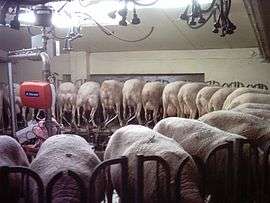Sheep milk
Sheep's milk (or ewes' milk) is the milk of domestic sheep. It is commonly used to make cultured dairy products such as cheese. Some of the most popular sheep cheeses include Feta (Greece), Ricotta (Italy) and Roquefort (France) [1]
Sheep breeds
Specialized dairy breeds of sheep yield higher amounts of milk compared to other breeds of sheep. Some of the most common dairy breeds include:
- East Friesian (Germany)
- Sarda (Italy)
- Lacaune (France)
- British Milk Sheep (U.K)
- Chios (Greece)
- Awassi (Israel)
- Assaf (Israel)
In the U.S the most common dairy breeds are the East Friesian and the Lacaune. [2] Finding a dairy sheep producer can be challenging so some may choose a non-dairy breed. Non-dairy breeds will not produce as much milk as a dairy breed but will produce enough milk to create small amounts of cheese and other products. Common non-dairy breeds of sheep include Icelandic, Finnsheep and Katahdin. [3]
Milk production period
Female sheep (ewes) do not produce milk constantly. Rather, they produce milk during the 80–100 days after the weaning of lambs.[4] Ewes start to produce milk immediately after lambing which naturally occurs in the early winter or early spring. Milk production decreases and eventually stops when lambs are weaned or when the day length becomes shorter. [2] Generally sheep breed in the fall which means that a majority of lambs are born in the early winter or early spring. This inconsistency of lambs means that milk cannot be produced year round. [5] Through the use of CIDRs (Controlled Internal Drug Release) ewes can be bred out of season. CIDRs contain progesterone which is slowly released into the bloodstream once being inserted which brings the animal into estrus. [6] This means that ewes can be bred at different times throughout the year providing farms with a year round supply of milk.
Non-dairy breeds of sheep lactate for 90-150 days while dairy breeds can lactate for 120-240 days. This means that dairy sheep are able to produce higher yields of milk per ewe per year. Dairy sheep can produce 400-1100 lbs of milk per year while non-dairy sheep produce 100-200 lbs of milk per year. Dairy and non-dairy crossbred ewes produce 300-650 lbs of milk per year. [2]
Products made from sheep milk
Sheep milk cheeses include the feta of Greece, the Roquefort of France, the Manchego of Spain; the Serra da Estrela from Portugal; the Pecorino Romano (the Italian word for sheep is pecora), the Pecorino Sardo, and the ricotta of Italy; and the Ġbejna of Malta; and the Gomolya of Hungary; Bryndza (Slovenská bryndza from Slovakia and Bryndza Podhalańska from Poland). Yogurts, especially some forms of strained yogurt, may also be made from sheep's milk.
Nutrition by comparison
Milk composition analysis, per 100 grams:[7]
| Constituents | unit | Cow | Goat | Water Buffalo | Sheep |
|---|---|---|---|---|---|
| Water | g | 87.8 | 88.9 | 81.1 | 83.0 |
| Protein | g | 3.2 | 3.1 | 4.5 | 5.4 |
| Fat | g | 3.9 | 3.5 | 8.0 | 7.0 |
| Carbohydrate | g | 4.8 | 4.4 | 4.9 | 5.1 |
| Energy | kcal | 66 | 60 | 110 | 95 |
| kJ | 275 | 253 | 463 | 396 | |
| Sugars (Lactose) | g | 4.8 | 4.4 | 5.1 | 4.9 |
| Saturated | g | 2.4 | 2.3 | 4.2 | 3.8 |
| Mono-unsaturated | g | 1.1 | 0.8 | 1.7 | 1.5 |
| Polyunsaturated | g | 0.1 | 0.1 | 0.2 | 0.3 |
| Cholesterol | mg | 14 | 10 | 8 | 11 |
| Calcium | IU | 120 | 100 | 195 | 170 |
| Fatty Acids: |
Sheep milk is extremely high in fat and conjugated linoleic acid (CLA) compared to other milk producing species. There is also a large amount of solids present in the milk. This makes sheep milk an excellent choice for making cheese and it produces higher yields of cheese compared to other milk producing species. For example, 1 liter of cow milk will yield a lower amount of cheese while 1 liter of sheep milk will produce a much higher amount of cheese. [8]
See also
References
- ↑ "Cheese Made from Domestic Sheep Milk". Ranker. Retrieved 2016-11-25.
- 1 2 3 Berger, Yves (2010). "Guide to Raising Dairy Sheep" (PDF).
- ↑ "Dairy Sheep Breeds". Milking Sheep. Retrieved 2016-11-25.
- ↑ Milk production period
- ↑ "Using Sheep CIDRs - Premier1Supplies Sheep Guide". Premier1Supplies Sheep Guide. 2012-10-15. Retrieved 2016-11-25.
- ↑ "CIDR".
- ↑ McCane, Widdowson, Scherz, Kloos
- ↑ Sinanoglou, Vassilia (2015). "Assessment of lactation stage and breed effect on sheep milk fatty acid profile and lipid quality indices". Journal of Dairy Science and Technology. 95: 509–531.
External links
- Sheep dairying at sheep101.com
- Sheep dairying documentary by Cooking Up A Story
